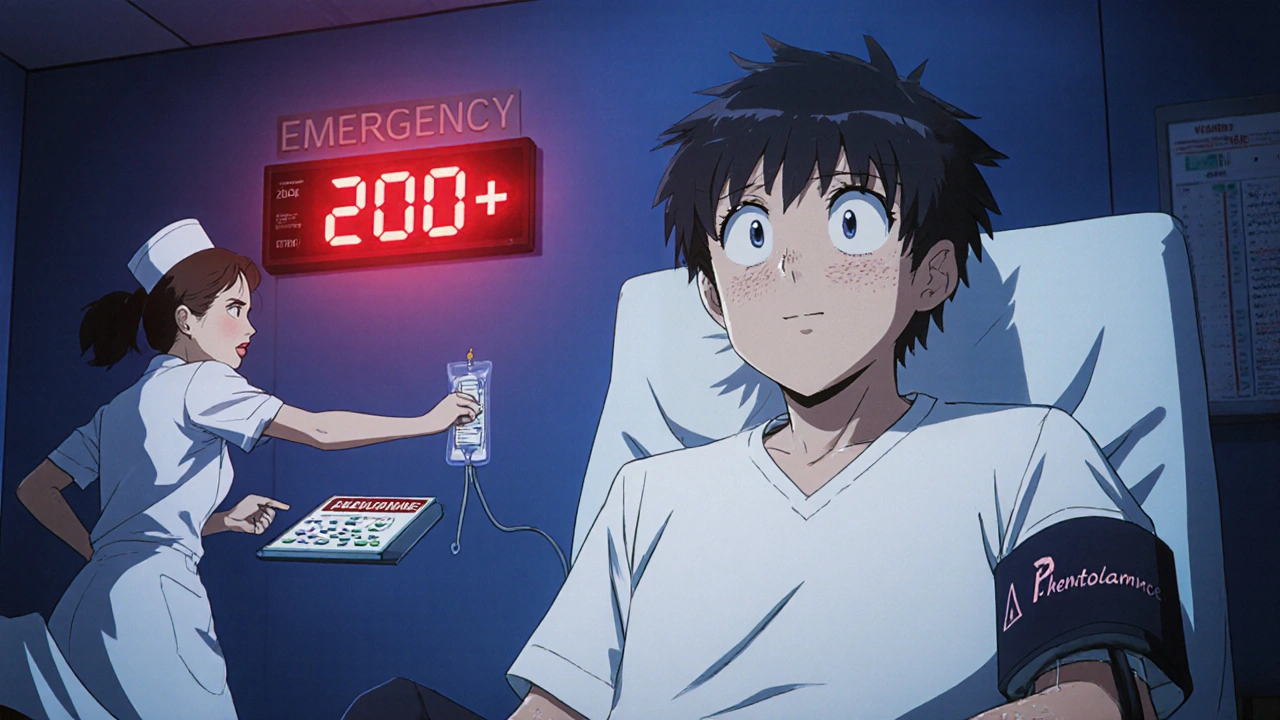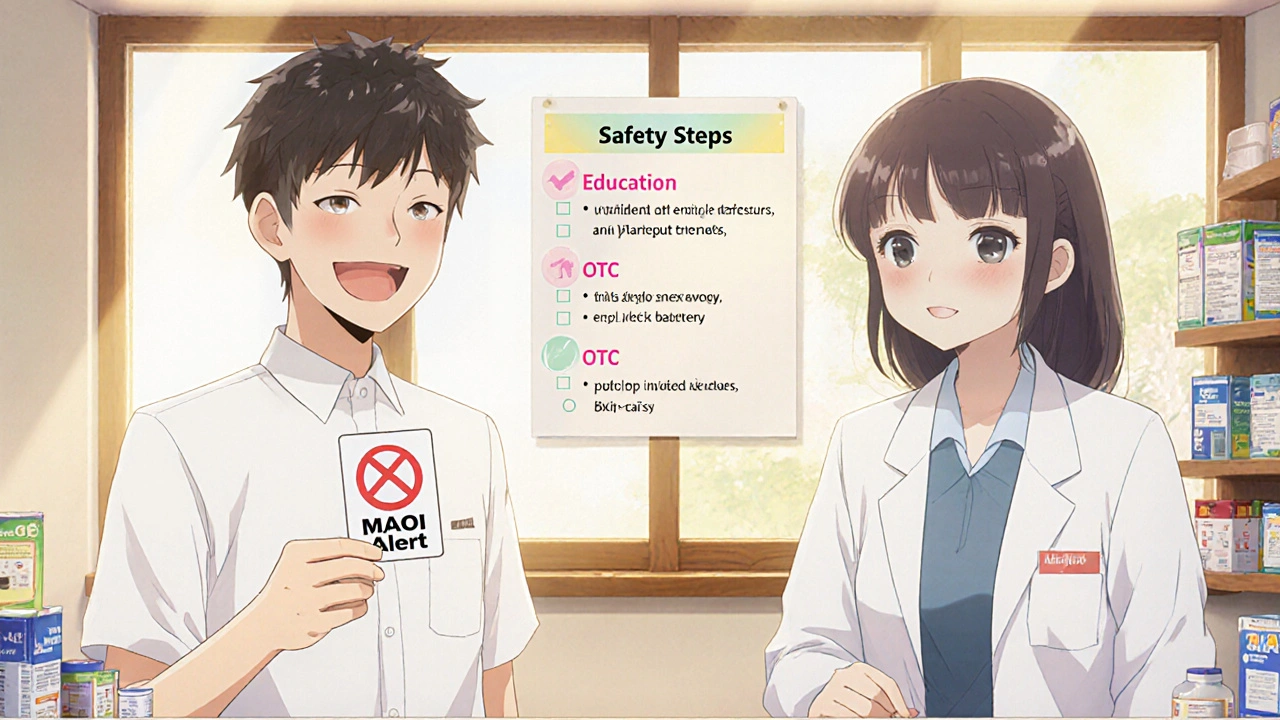MAOI-Ephedrine Risk Assessment
Risk Assessment Tool
Select your MAOI type and ephedrine dose to determine your risk of hypertensive crisis. This tool is designed for healthcare professionals and patients on MAOI therapy.
Risk Assessment Results
When we talk about Ephedrine is a sympathomimetic amine that stimulates norepinephrine release and blocks its reuptake, we’re usually thinking of cold medicines or weight‑loss supplements. Pair that with Monoamine oxidase inhibitors (commonly called MAOIs) - a class of antidepressants that block the enzyme that breaks down norepinephrine, serotonin, and dopamine - and you’ve got a recipe for a dangerous spike in blood pressure.
Why does this happen? Because both drugs push the same chemical pathways in opposite directions. The result can be a sudden, life‑threatening hypertensive crisis. If you or someone you know is on an MAOI, knowing the red‑flag signs and the exact steps to avoid disaster can literally save a life.
Understanding the Interaction
Think of MAOIs as the body’s brake on catecholamines (norepinephrine, dopamine, serotonin). Ephedrine, on the other hand, is like stepping on the gas pedal. When the brake is removed (MAOI) and the gas is floored (ephedrine) at the same time, blood pressure can sky‑rocket past 200 mmHg within minutes.
Key points to remember:
- MAOIs inhibit the enzyme monoamine oxidase, preventing normal breakdown of norepinephrine.
- Ephedrine forces more norepinephrine out of nerve endings and also blocks its reuptake.
- The combined effect overwhelms the vascular system, causing severe vasoconstriction.
Mechanism Behind the Crisis
Under normal circumstances, about 90 % of dietary tyramine and other pressor amines are degraded in the gut and liver by monoamine oxidase. When that enzyme is blocked, tyramine can displace norepinephrine from storage vesicles, flooding the synapse. Ephedrine amplifies this surge by stimulating the release and preventing the re‑absorption of norepinephrine.
The timeline is frighteningly short: blood pressure spikes can appear 30-120 minutes after ingestion, often accompanied by pounding headaches, nausea, sweating, dilated pupils, and a racing or irregular heartbeat. In extreme cases, patients have suffered subarachnoid hemorrhage or intracerebral bleed within an hour of taking a single dose.
Which MAOIs Pose the Greatest Risk?
| MAOI (example) | Inhibition Type | Typical Washout Period | Tyramine Sensitivity (mg) | Crisis Risk with Ephedrine |
|---|---|---|---|---|
| Phenelzine (Nardil) | Irreversible (MAO‑A) | 14 days | 10‑25 | Very High |
| Tranylcypromine (Parnate) | Irreversible (MAO‑A) | 14 days | 10‑30 | Very High |
| Isocarboxazid (Marplan) | Irreversible (MAO‑A) | 14 days | 10‑20 | Very High |
| Selegiline (Emsam) - low dose | Selective MAO‑B (reversible) | 24‑48 hrs | ~100 | Low‑Moderate |
| Moclobemide | Reversible | 24‑48 hrs | ~100 | Low |
In short, the irreversible MAO‑A inhibitors are the biggest danger zones. Even a low‑dose ephedrine tablet (12.5‑25 mg) can trigger a crisis when paired with these drugs.

Clinical Signs & Emergency Management
When a hypertensive crisis erupts, the clinical picture can look like this:
- Systolic BP > 180 mmHg (often > 200 mmHg)
- Sudden, severe occipital headache radiating to the front
- Palpitations or irregular heart rhythm
- Neck stiffness, nausea, vomiting
- Diaphoresis, dilated pupils, photophobia
If you suspect a crisis, the first step is rapid blood pressure reduction with intravenous phentolamine (5‑15 mg). Sublingual nifedipine is a strict no‑no because the sudden drop can cause cerebral hypoperfusion and stroke.
Practical Prevention Strategies
Prevention is far easier than rescue. Here’s a checklist you can hand to patients or keep in your clinic’s reference folder:
- Educate every MAOI patient about the absolute contraindication with any sympathomimetic agent. Provide a printed list of OTC decongestants (ephedrine, pseudoephedrine, phenylephrine, phenylpropanolamine).
- Give each patient an MAOI alert card to carry in wallets. A 2023 Mayo Clinic survey found 87 % of card‑carriers avoided accidental exposure.
- Enforce a washout period: 14 days after stopping irreversible MAOIs, 24‑48 hrs after reversible agents.
- Document the interaction in the electronic health record with a hard stop for any prescription containing ephedrine‑type agents.
- Encourage patients to ask pharmacists to double‑check any new medication, even “just a cold pill.”
For non‑psychiatric prescribers, a quick glance at the patient’s medication list for “MAOI” should trigger a flag to avoid any product that mentions “decongestant” or “weight‑loss” on the label.

Case Highlights From the Literature
Real‑world stories underscore why vigilance matters.
- In 1965, Dr. M.S. Hirsch reported a 49‑year‑old woman who suffered a subarachnoid hemorrhage within 30 minutes of a single ephedrine dose while on nialamide (100 mg daily).
- A 2018 case in the Journal of Clinical Psychopharmacology described a 32‑year‑old man whose systolic pressure hit 240 mmHg after a 25 mg ephedrine tablet alongside phenelzine 45 mg. He required emergency phentolamine and survived.
- Reddit users (2022) have posted “near‑fatal” accounts of sudden, blinding headaches and vision loss after inadvertently taking OTC cold meds while on phenelzine.
- The FDA’s Adverse Event Reporting System logged 37 ephedrine‑MAOI crises from 2015‑2020, nine of which were fatal.
These anecdotes are more than headlines-they illustrate a pattern that repeats when the same safety steps are ignored.
Key Takeaways
- MAOIs remove the enzymatic brake on norepinephrine; ephedrine simultaneously slams the accelerator.
- Irreversible MAO‑A inhibitors (phenelzine, tranylcypromine, isocarboxazid) carry the highest risk; even low doses of ephedrine can trigger a crisis.
- Recognize the classic symptom cluster (headache, palpitations, nausea, high BP) and treat immediately with IV phentolamine.
- Prevention hinges on patient education, printed alert cards, clear pharmacy warnings, and a 14‑day washout after irreversible MAOIs.
- When in doubt, assume any over‑the‑counter decongestant contains a sympathomimetic amine and avoid it.
Bottom line: if you’re on an MAOI, treat any product that contains ephedrine as a medical emergency waiting to happen. The safest route is simple-don’t mix.
Frequently Asked Questions
Can I take a pseudoephedrine cold pill while on an MAOI?
No. Pseudoephedrine works the same way as ephedrine-stimulating norepinephrine release. Combining it with any MAOI can cause a hypertensive crisis.
How long do I need to wait after stopping an irreversible MAOI before using ephedrine?
At least 14 days. The enzyme needs that time to regenerate fully.
Are transdermal selegiline patches safer?
They are safer at low doses because they selectively inhibit MAO‑B, but the risk isn’t zero. Stick to the same avoidance rules.
What is the first‑line emergency drug for an MAOI‑ephedrine crisis?
IV phentolamine (5‑15 mg) is the drug of choice because it directly blocks alpha‑adrenergic receptors and quickly lowers BP.
Should I carry an alert card even if I only take an MAOI occasionally?
Absolutely. Even a single accidental dose of ephedrine can be fatal, and the card reminds every healthcare provider of the absolute contraindication.


Comments
Picture this: a patient on phenelzine reaches for an over‑the‑counter cold pill, unsuspecting of the ticking time bomb.
When ephedrine hits the system, the already‑blocked MAO‑A can't keep up, and norepinephrine floods the bloodstream.
The result? A blood pressure spike that feels like a jackhammer inside your skull.
I've seen the panic in emergency rooms, the beeping monitors, the frantic nurses shouting for phentolamine.
It’s a stark reminder that even a "tiny" decongestant can turn lethal in minutes.
Stay vigilant, double‑check every label – your life could depend on it.
That checklist you mentioned is gold-simple, clear, and totally doable for anyone on an MAOI.
Sharing an alert card with patients not only reduces accidental exposure but also empowers them to ask pharmacists the right questions.
Keeping the washout periods in mind, especially the 14‑day rule after irreversible inhibitors, is the cornerstone of safety.
Great job breaking it down into bite‑size steps!
Never mix ephedrine with MAOIs.
Ah, the miracle of “simple steps”-as if a glossy card could outsmart a neurochemical avalanche.
In reality, we’re talking about α‑adrenergic overdrive, vascular constriction, and the hyper‑acute risk of intracranial hemorrhage.
But kudos for championing patient‑centered protocols; the more redundancies, the better the safety net.
Irreversible MAO‑A inhibitors present the highest danger; avoid any sympathomimetic.
Exactly, and it’s worth emphasizing that even “harmless” OTC products can contain hidden sympathomimetics.
Educating patients to read ingredient lists and consult pharmacists is the key to preventing those catastrophic spikes.
The pharmacodynamic interaction between ephedrine and MAO inhibitors is a textbook example of synergistic catecholamine excess.
When you block the enzymatic degradation pathway with an irreversible MAO-A inhibitor, you essentially remove the brake on norepinephrine metabolism.
Adding ephedrine, which forces additional norepinephrine release and blocks its reuptake, is like flooring the accelerator while the brakes are cut.
The resultant surge in synaptic norepinephrine leads to massive α‑adrenergic vasoconstriction.
Clinically this manifests as a hypertensive crisis with systolic pressures that can exceed 200 mmHg within minutes.
The body’s compensatory mechanisms are overwhelmed, and baroreceptor reflexes cannot normalize the pressure quickly enough.
Moreover, the increased catecholamine load can precipitate arrhythmias, especially in patients with underlying cardiac disease.
The literature documents numerous cases where a single 25 mg ephedrine tablet triggered subarachnoid hemorrhage in patients on phenelzine.
A 14‑day washout period after stopping irreversible MAO‑A inhibitors is not a suggestion but a pharmacokinetic necessity, because the enzyme turnover requires roughly two weeks.
Some clinicians mistakenly think that reversible inhibitors like moclobemide are exempt, but even those can pose risks at higher ephedrine doses.
The FDA’s adverse event database shows a worrying trend of fatal outcomes when the interaction is overlooked.
Therefore, the precautionary principle dictates that any product containing ephedrine, pseudo‑ephedrine, phenylephrine, or similar sympathomimetics must be categorically avoided.
Patient education should include a printed “MAOI alert card” that lists prohibited substances in plain language.
Pharmacists also play a crucial role; a hard stop in the electronic prescribing system can catch inadvertent prescriptions before they reach the patient.
Lastly, clinicians should document the interaction note prominently in the medical record to ensure continuity of care.
Ignoring these steps definatly puts patients at unnecessary risk and is simply unacceptable practice.
While the chain of reasoning you laid out is exhaustive, the tone borders on alarmist, potentially scaring patients away from necessary treatment.
Balancing risk communication with reassurance is essential; a measured approach, highlighting both the danger and the practical steps, usually yields better adherence.
In summation, the confluence of sympathomimetic agents with monoamine oxidase inhibition engenders a pathophysiological milieu wherein catecholaminergic dysregulation precipitates an acute hypertensive cataclysm.
Such an event warrants immediate pharmacologic intervention with agents such as phentolamine, whose α‑adrenergic antagonism efficaciously attenuates vascular tone.
It is incumbent upon the prescribing clinician to meticulously delineate contraindications within the therapeutic algorithm, thereby mitigating iatrogenic sequelae.
Wow, that reads like a Shakespearean tragedy of blood pressure!
Indeed, the eloquence of the previous exposition renders the clinical stakes almost theatrical, yet the underlying imperative remains stark: any deviation from strict contraindication protocols is tantamount to courting disaster.
Great discussion, everyone. The takeaway is clear – keep the MAOI patients informed, double‑check meds, and have that alert card handy.
When we all stay on the same page, we keep the “gas pedal” off and the “brake” intact.